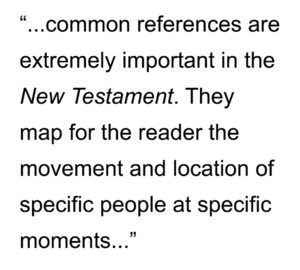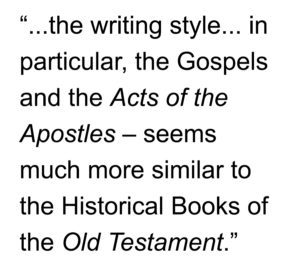The Biblical City: Of, In, The…
by Dr. Mark David Major, AICP, CNU-A, The Outlaw Urbanist contributor
Can the Holy Bible tell us anything about urbanism?
There over eight hundred and fifty (850) common references to the city in the Holy Bible. There are over four-and-a-half times the number of common references to the city in the Old Testament than in the New Testament. This is unsurprising since the Old Testament has about four-and-a-third more words than the New Testament, depending on translation and which books are included.
Of the approximately one hundred and fifty (150) common references to the city in the New Testament, over twenty-one percent (21%) occur in the Book of Revelation alone. Outside of this, there are only six (6) common references to the city, which appear more significant than merely indicating a geographical place; two (2) in the Gospel of Matthew (or simply Matthew) and four (2) in St. Paul’s Letter to the Hebrews (or simply Hebrews). More than half (51%) of the common references to the city in New Testament are nouns denoting the location/direction of a specific person in space (“He went into the city”, e.g. he was outside but now he is inside), often after a proper name (e.g. Jerusalem) was previously used in the text.  These common references are extremely important in the New Testament. They map for the reader the movement and location of specific people at specific moments, most usually Jesus and his Apostles, or in recounting past events/parables during the course of the primary action of a specific text. More than a third (36%) of the common references are a non-possessive, non-relational subject or object (direct or indirect) of a sentence. (e.g. “The city was…” or “…a city”). Again, this often occurs after a proper name was previously used in the text (i.e. we already know where the action is taking place). Finally, only eleven percent (11%) of the common references in the New Testament are possessive nouns (e.g. “the priests of the city”). These possessive nouns are often important for denoting differences; for example, between insider (e.g. resident or citizen) and outsider (e.g. visitor or stranger), the powerful (e.g. priests) and the powerless (e.g. poor), or other such relationships presented as a dichotomy in the narrative.
These common references are extremely important in the New Testament. They map for the reader the movement and location of specific people at specific moments, most usually Jesus and his Apostles, or in recounting past events/parables during the course of the primary action of a specific text. More than a third (36%) of the common references are a non-possessive, non-relational subject or object (direct or indirect) of a sentence. (e.g. “The city was…” or “…a city”). Again, this often occurs after a proper name was previously used in the text (i.e. we already know where the action is taking place). Finally, only eleven percent (11%) of the common references in the New Testament are possessive nouns (e.g. “the priests of the city”). These possessive nouns are often important for denoting differences; for example, between insider (e.g. resident or citizen) and outsider (e.g. visitor or stranger), the powerful (e.g. priests) and the powerless (e.g. poor), or other such relationships presented as a dichotomy in the narrative.
The last might signify an important difference. Of the approximately seven hundred (700) common references to the city in the Old Testament, nearly twenty-seven percent (27%) are possessive nouns. Almost two-and-a-half times more possessive nouns are used in the Old Testament than the New Testament, in relative terms. There are several plausible reasons for this difference. It might be a simple quirk of translation, which arises for a variety of reasons. For example, most of the Torah is translated from Hebrew and the New Testament from Greek. Alternatively, perhaps it is simply because the texts of the New Testament are younger than those of the Torah. Another possibility is a difference in the scale of human perspective about their world. The perspective of the New Testament is a Roman World. The perspective of the Old Testament is limited to the region of Judea, Egypt and Mesopotamia. This might have led to a change in writing style, abrogating the perceived need for extensive use of possessive nouns. Or, it might be a consequence of all these factors. In any case, this might be important because the writing style of the New Testament – and, in particular, the Gospels and the Acts of the Apostles – seems much more similar to the Historical Books of the Old Testament (Joshua through Maccabees) than the other books.  Nearly three hundred (300) or forty-two percent (42%) of the common references to the city in Old Testament are nouns denoting the location/direction of a specific person in space. However, the Historical Books deploy these common references at a greater frequency than the rest of the Old Testament. Over forty-five percent (45%) of the common references to the city in the Old Testament occur in the Historical Books. Finally, about thirty-one percent (31%) of the common references to the city in the Old Testament are a non-possessive, non-relational subject or object (direct or indirect) of a sentence. What this suggests, whatever you might believe, is the writers of the Gospels and Acts believed they were writing histories and adopted the appropriate writing style for that endeavor drawing upon the model of Old Testament texts.
Nearly three hundred (300) or forty-two percent (42%) of the common references to the city in Old Testament are nouns denoting the location/direction of a specific person in space. However, the Historical Books deploy these common references at a greater frequency than the rest of the Old Testament. Over forty-five percent (45%) of the common references to the city in the Old Testament occur in the Historical Books. Finally, about thirty-one percent (31%) of the common references to the city in the Old Testament are a non-possessive, non-relational subject or object (direct or indirect) of a sentence. What this suggests, whatever you might believe, is the writers of the Gospels and Acts believed they were writing histories and adopted the appropriate writing style for that endeavor drawing upon the model of Old Testament texts.
NEXT: Part 3, The Biblical City Redux
The Biblical City is a new series from The Outlaw Urbanist.

